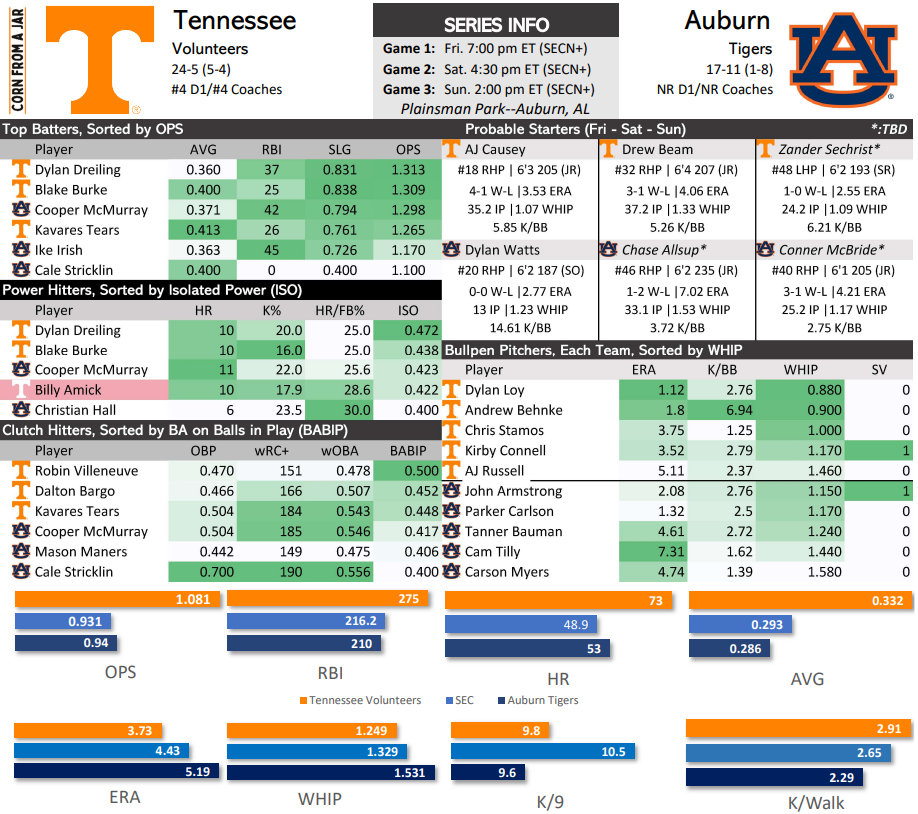Basketball Glossary
It's crazy what you can do with Excel. I made this:
 |
| You can always click on these for a bigger version |
These will be posted with the Vols' info updated at least weekly, and with opponent information before any big game. You'll see minor changes in this over the course of the season, but for now I like the bones of it, so this will be the general format. Starting at the top:
Top line: rank, team, record (overall, conference). Pretty self-explanatory. Below that you will see the "four factors" that are predictive of success in basketball (much like the five factors in football). they are: shooting, turnovers, rebounding, and free throws. They are measured here by using:
- Effective Field Goal % (eFG%): a way of measuring field goal percentage that weights 3s as more valuable. The formula is (FG + 0.5 * 3P) / FGA.
- Turnover Percentage (TOV%): an estimate of turnovers per 100 minutes. The formula is TOV / (FGA + 0.44 * FTA + TOV).
- Offensive and Defensive Rebound Percentage (ORB%/DRB%): the percentage of rebounds you're getting on offense or defense when there is a rebound opportunity. The formula for offense is ORB / (ORB + Opponent's DRB), the formula for defense is DRB / (DRB + Opponent's ORB).
- Free Throw Rate (FTRt): a measure of how much free throws factor into a team's offense. The formula is FT / FGA.
Picture, name, height, weigh, year--those are all obvious I think. I realize I should probably add jersey number and position. You can probably figure out the bar graph to the right of each player, too; those are simply traditional stats like field goal % and 3-point %. I can make those reflect pretty much any statistic, and one of the items on my road map is to make those more individually relevant to reflect the specific player's strengths and weaknesses.
The least obvious things in each of those blocks is the color-coded numbers and the graphics that appear next to some players. First, for the six numbers in the middle. There are individual, holistic stats that are meant to give a picture of a player's impact on the court. The NBA uses 10 or more of these numbers. For college ball, there are fewer such stats that are readily available:
- Player Efficiency Rating (PER): One of the first all-in-one player metrics, PER aims to give a per-minute rating of a player's performance. You can read more about it here. As a statistic, it has detractors--that it doesn't account for defense or that it overvalues scoring, for a couple. But it's a standardized number that gives some context to a player's contribution, and it's easy enough for me to find.
- Win Shares per 40 Minutes (WS/40): Similar to the same stat in baseball, win shares are meant to show how much a player contributed to a team's win. Unlike baseball, which basically counts three win shares for each team win, a basketball team's win shares should add up to the team's win total. Further explanation here.
- Box Plus/Minus (BPM): An estimate of a player's scoring contribution above the average player per 100 possessions. Read more.
- Offensive Rating/Defensive Rating (ORtg/DRtg): For offensive rating, it's the points produced per 100 possessions (note it's produced, not scored). Defensive rating accounts for the points allowed per 100 possessions. See here for more on how the numbers are calculated. Generally, offensive rating is considered a more important stat. But we are disciples of Deacon Barnes, so you bet we'll be including defensive rating as well.
- Usage (USG%): An estimate of the team's plays used by a player while he's on the floor. The formula is 100 * ((FGA + 0.44 * FTA + TOV) * (Tm MP / 5)) / (MP * (Tm FGA + 0.44 * Tm FTA + Tm TOV)).
- "Scoring Specialist:" signified by a rocket ship, and like "Super Defender" it's given to players in the top 10 of three offensive categories.
- "Burglar:" top 5 player in steals
- "Cleaner:" top 5 player in a rebounding category, or top 10 in multiple categories
- "Helper:" top 5 player in assists or produced points (a stat that measures scoring, assists, and offensive rebounds), or top 10 in both categories





Comments